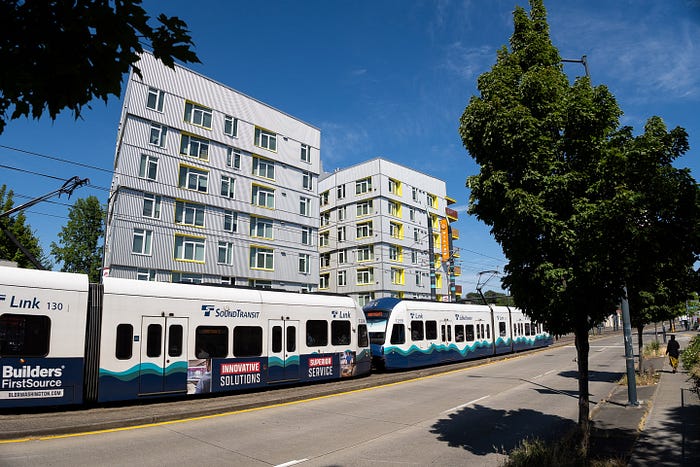Washington – (Release from Gov. Jay Inslee’s Office) More than 1 million new residents have arrived in the last decade. To accommodate this growth, and to meet aggressive emissions reduction targets, state and local governments must plan together.
Failing to plan would be planning to fail the state’s critical climate goals.
Gov. Jay Inslee requested legislation this session to improve the state’s response to climate change by updating the Washington Growth Management Act (GMA). The bill, sponsored by Rep. Davina Duerr, passed off the floor of the state House of Representatives on Mar. 3.
“We can do a better job of planning, adapting, and building more sustainably,” Duerr said. “This legislation is about protecting our homes and small businesses from floods, wildfires, droughts, and the growing dangers caused by climate change.”
The legislation requires cities and counties to plan to reduce emissions and build more livable and connected communities. The GMA provides a sustainable planning framework for local governments — adding improvements to account for climate change equips communities to plan and deal with its well-known impacts

What is the Washington Growth Management Act?
Uncoordinated growth could hurt the state, its economy, and the environment. Planning for energy generation, water service, transportation, or other infrastructure would be impossible without understanding how communities might grow or change. Uncoordinated sprawl would destroy ecosystems and isolate communities.
The Legislature adopted the first set of GMA policies in 1990, not to consolidate local planning at the state level, but to allow fast-growing local governments to plan independently while meeting critical standards. Standards address sprawl reduction, mobility, economic development, historic preservation, and environmental protection.
Lack of planning and coordination can result in dire outcomes. In Arizona, the City of Scottsdale recently severed water transportation to Rio Verde Foothills, a small suburban community about 30 miles away. Scottsdale officials had long warned that reckless development and shrinking reservoirs might lead to crisis.
“The city cannot be responsible for the water needs of a separate community especially given its unlimited and unregulated growth,” read one statement from the city.
Accommodating growth while meeting sustainability goals requires coordination between governments big and small.
How are Washington communities planning for climate change?
Some cities are already setting an example for the rest of the state. The state Department of Commerce recently awarded the City of Lakewood a “Smart Climate Strategies Award” for the city’s planning to reduce emissions and build housing.
“As policy-makers, we know the decisions we make today will have a lasting impact on the future of our city,” said Lakewood Mayor Jason Whalen. “That’s why we took a proactive approach to determine how climate change is affecting our environment and specifically what that means for future growth and development in Lakewood.”
When Lakewood adopted a new Energy & Climate Change Chapter in its comprehensive plan to address climate change, it set 87 new, ambitious goals. The city set out to enhance its tree preservation code, develop a five-year emissions reduction plan, update its active transportation plan, evaluate its floodplains, develop an urban forest management plan, and more.
“When it comes to tackling the important issues of the day, including the impacts of climate change, we are all in this together,” said Whalen.

How might new laws improve GMA to meet state goals?
At Gov. Jay Inslee’s request, legislation has been introduced by Sen. Liz Lovelett and Rep. Davina Duerr to establish a new climate change and resiliency goal within the GMA. It would require local governments to plan for reduced emissions, efficient transportation, increased housing capacity, reduced pollution in overburdened communities, and extreme weather events.
Adding these requirements will ensure local governments are helping pull all of Washington toward a sustainable future.
Advancing environmental justice
The bill includes new requirements to integrate environmental justice principles into local planning.
The U.S. Environmental Protection Agency defines “environmental justice” as the fair treatment and meaningful involvement of all people regardless of race, color, national origin, or income with respect to the development, implementation, and enforcement of environmental laws, rules, and policies.
Hazards such as PM2.5-diesel emissions, ozone concentration, proximity to high-traffic roadways, household lead exposures, and proximity to hazardous sites are all mapped by the state Department of Health. The map reveals striking concentrations of risk in low-income communities.
The new bill requires local good-faith efforts to reduce harm to overburdened and vulnerable communities.
Building more and smarter housing
Washington state has a housing crisis. For the 1 million new residents the state welcomed over the last decade, only 300,000 new units were built. As a result, well-paid beneficiaries of the state’s powerful economy compete for housing (and more often prevail) over lower-income residents. Rents and homelessness have risen together.
The village of Langley was recently recognized by the Department of Commerce for efforts to expand “missing middle” housing while preserving its unique small-town feel. The village is proof that housing development need not be at the expense of local charm.

The state Department of Commerce has awarded grants to forward-thinking communities like Langley doing their part to plan for smarter housing and growth.
Inslee’s proposals for the 2023 legislative session have prioritized housing through record funding and relaxed zoning. Improved GMA provisions would help address the housing crisis at the same time as the climate crisis.
The bill concentrates housing construction in urban growth areas and transit corridors, and it would limit encroachment into wildland areas and green space.
Rebounding from natural hazards
Historic weather events have rocked the state in recent years. Wildfires, mudslides, heat, drought, storms — all have been made more frequent and dramatic by climate change.
The bill would not only protect wildlands and dangerous areas from development pressure, but it would require local governments to plan for resilience. Local governments would have to ready their communities for disaster, prioritizing vulnerable populations.
Lakewood, for example, is revisiting floodplain analysis in response to changing conditions. City plans note that eight of the region’s top 10 peak floods have been recorded since 2006, and that reduced snowpack on Mt. Rainier might contribute to increase sediment loads and flood risk in nearby rivers.
Climate change brings more extreme weather events, and Washington cities and counties must be ready for them.

Moving people around town
The bill’s focus on density and urban growth would consolidate populations along transit corridors rather than spread people out where no transit could reach them. Over time, smart planning will lower vehicle miles traveled per capita.
Urban growth keeps people near jobs, services, stores, and amenities. Smart transit shuttles people about their lives without snaring them in traffic or choking the air with emissions.
The bill is also important to reach Washington’s statutory goal of reducing vehicle miles traveled (VMT) 50 percent by 2050. The Legislature established the goal in 2008, using estimates that put the annual per capita vehicle miles traveled at the time at 75 billion.
The bill would require planning for growth in coordination with state and local transportation agencies. The bill would also advance planning for “active transportation” cycling and walking infrastructure. The goal is for each Washington city to become an easier place to get around.
Reducing emissions
The new bill’s primary intent is to reduce emissions. Washington state has enacted ambitious policies to reduce emissions from transportation, buildings, energy generation, and other sources. The state intends to transition to a net-zero clean energy economy by 2050. To complete that transition, cities, and counties must be part of the transition.
By planning smart growth, enhancing transit, reducing vehicle miles, improving walkability, protecting green space, preserving natural areas, and building sustainable housing, a refreshed Washington Growth Management Act would substantially reduce emissions and improve communities statewide.

















